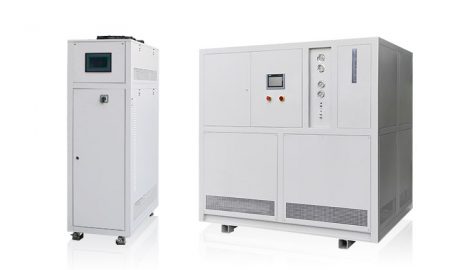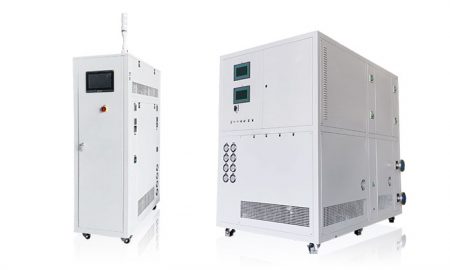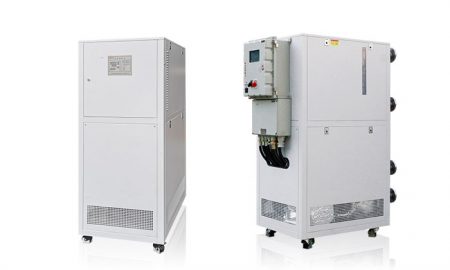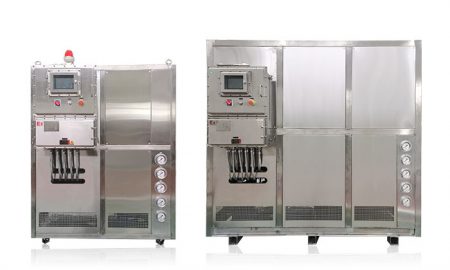Heater Cooler Unit – Reactor Temperature Control System
In the pharmaceutical and chemical industry, the reactor must participate in various industrial process production processes and carry out various chemical reactions. The materials in the reactor need to undergo various rapid temperature rise and fall. In order to meet various temperature requirements, a heater cooler unit can be used To control the temperature of the reactor at high temperature and low temperature, to indirectly reduce the temperature of the material in the reactor.
First, the types of heater cooler unit-reactor temperature control equipment:
To control the temperature of the reactor jacket, in addition to the heater cooler unit, we also have high and low temperature integrated machines, TCU temperature control units, refrigeration heating cycle machines, heating devices, chillers, ultra-low temperature chillers and other equipment to help solve the problem of jacket temperature control .
Second, heater cooler unit-reactor temperature control process:
The heater cooler unit is a relatively wide range of temperature control equipment. In the production process of chemical reactions, the reactor needs constant temperature control in many links, and high and low temperature dynamic temperature control is also required under complex conditions.
In the production of various chemical and pharmaceutical industries, chemical raw materials or solutions are reacted, synthesized, extracted, etc. in the reactor. Usually, the reactor needs to provide a certain temperature, so as to speed up or meet the requirements of the process. The reaction kettle matched with the heater cooler unit generally has an internal cavity, which is usually a jacket or a coil. The materials that need temperature control are placed in this cavity, and the internal cavity is surrounded by a jacket layer that can pass through the heat transfer medium. The heater cooler unit is connected to the jacket of the reactor, and the reactor precisely controls the temperature of the oil. The machine realizes dynamic cooling and heating control, and the heat transfer medium is heated and cooled in the temperature control device.
Many chemical reactions are accompanied by a large amount of endothermic or exothermic phenomena, and the temperature control process of the heater cooler unit is an important process parameter in the production process. The refrigeration and heating cycle machine adopts a large flow high temperature resistant oil pump. Reliable performance and stable quality can prevent shaft seal oil leakage and reduce the temperature difference between the inlet and outlet of heat transfer oil.
Third, heater cooler unit-reactor temperature control method:
There are several ways to control the temperature of the reactor. When selecting the temperature control method of the heater cooler unit, various conditions and influencing factors need to be considered comprehensively. Three methods are generally used: conduction, convection and radiation.
1. Conduction Heat is transferred from the part with higher temperature to the part with lower temperature along the object, which is called conduction.
2. Convection The way heat is transferred by the flow of liquid or gas is called convection.
3. Radiant heat is emitted from objects along a straight line, which is called radiation.
At present, convection is a more suitable method for the heating and temperature control of chemical reaction kettles. The heat conduction oil is heated by the heating tube and then pumped out through the circulating pump for heat exchange. If there is an explosion-proof requirement, it can be treated with explosion-proof treatment, and the operation is simple. , strong flexibility, convenient process rectification and other advantages in later working conditions, compared with other heating methods, the cost investment is more suitable.
Maßgeschneiderte Lösungen für Ihr Unternehmen

Kühl- und Heizsysteme (Serie SUNDI)
Temperaturregelbereich: -120°C bis +350°C
Anwendung: Verschiedene Reaktoren (Mikrokanäle, Glas, ummantelte Reaktoren usw.), Destillations- oder Extraktionssysteme, Labor, Universität, Forschungsinstitut, Luft- und Raumfahrt, Automobilindustrie, Halbleiter- und Elektrotests, Chemie, Pharmazie, Petrochemie, Biochemie, Medizin, Krankenhaus, F&E-Werkstatt, Luft- und Raumfahrt, Biologie und andere Industrien.
| Temperaturbereich | Serie -40 ~ +200°C | Serie -10 ~ +200°C | Serie -25 ~ +200°C | Serie -25 ~ +300°C | Serie -45 ~ +250°C | Serie -45 ~ +300°C | Serie -60 ~ +250°C | Serie -60 ~ +300°C | Serie -70 ~ +250°C | Serie -80 ~ +250°C | Serie -90 ~ +250°C | Serie -100 ~ +100°C | -25 ~ +200°C eine Maschine für zwei Reaktoren | -40 ~ +200°C eine Maschine für zwei Reaktoren |
| Kühlleistung | bis zu 3kW | bis zu 15kW | bis zu 200kW | bis zu 200kW | bis zu 200kW | bis zu 25kW | bis zu 60kW | bis zu 25kW | bis zu 15kW | bis zu 80kW | bis zu 80kW | bis zu 80kW | bis zu 10*2kW | bis zu 10*2kW |

Kühl- und Heizsysteme (WTD-Serie)
(Mikrokanal / Röhrenreaktoren spezialisiert)
Temperaturregelbereich: -70°C bis +300°C
Spezielles Design für Mikrokanäle (geringe Flüssigkeitsspeicherkapazität, starke Wärmeaustauschkapazität, Zirkulationssystem mit hohem Druckabfall)
| Temperaturbereich | -70°C ~ +300°C | -45°C ~ +250°C | -70°C ~ +200°C |
| Kühlleistung | bis zu 7,5 kW | bis zu 5,5 kW | bis zu 50kW |

Kühl- und Heizsysteme (TES-Serie)
Temperaturregelbereich: -85°C ~ +250°C
Temperaturregelungsgenauigkeit: ± 0,3°C
| Temperaturbereich | Serie -45°C ~ +250°C | Serie -85°C ~ +200°C | Serie -60°C ~ +200°C |
| Kühlleistung | bis zu 25kW | bis zu 25kW | bis zu 60kW |

Kühl- und Heizmaschinen (LTS-Serie)
Temperaturregelbereich: -80°C bis +80°C
Es wird häufig in der Halbleiterindustrie eingesetzt, um die Temperatur der Reaktionskammer, der Heizplatte und des nicht brennbaren Wärmeträgers zu regeln.
| Temperaturbereich | -20°C ~ +80°C Reihe | Serie -45°C ~ +80°C | Serie -60°C ~ +80°C | Serie -80°C ~ +80°C |
| Durchflusskontrolle | 7 ~ 45 L/min | 7 ~ 45 L/min | 7 ~ 45 L/min | 7 ~ 45 L/min |

Umwälzpumpen für Kühlung und Heizung
Temperaturregelbereich: -45°C bis +250°C
Anwendung: Verschiedene Reaktoren (Mikrokanäle, Glas, ummantelte Reaktoren usw.), Destillations- oder Extraktionssysteme, Labor, Universität, Forschungsinstitut, Luft- und Raumfahrt, Chemie, Pharmazie, Petrochemie, Biochemie, Medizin, Krankenhaus, F&E-Werkstatt, Luft- und Raumfahrt, Biologie und andere Industrien.
| Temperaturbereich | Serie -25°C ~ +200°C | Serie -45°C ~ +250°C |
| Kühlleistung | bis zu 15kW | bis zu 15kW |

Heizungsumwälzpumpen
Temperaturregelbereich: +50°C bis +300°C
Hinweis: Die UC-Serie kann die Temperatur des Wärmeträgermediums regeln. Die UST-Serie kann nicht nur die Temperatur des Wärmeträgermediums, sondern auch die Temperatur des Reaktionsmaterials regeln.
| Temperaturbereich | +50°C ~ +200°C (UC-Serie) | +50°C ~ +300°C (UC-Serie) | +50°C ~ +300°C (UST-Serie) |
| Heizleistung | bis zu 38kW | bis zu 200kW | bis zu 95 kW |

TCU Multireaktoren Temperaturkontrollsystem
Temperaturregelbereich: -120°C bis +250°C
Anwendung: Verschiedene Reaktoren (Mikrokanäle, Glas, ummantelte Reaktoren usw.), Destillations- oder Extraktionssysteme, Labor, Universität, Forschungsinstitut, Luft- und Raumfahrt, Chemie, Pharmazie, Petrochemie, Biochemie, Medizin, Krankenhaus, F&E-Werkstatt, Luft- und Raumfahrt, Biologie und andere Industrien.
| Temperaturbereich | Serie -45°C ~ +250°C | -120°C ~ +250°C Reihe | Kundenspezifisches Temperaturkontrollsystem | RT+10°C ~ +135°C |
| Heizleistung | bis zu 80kW | bis zu 80kW | Benutzerdefiniert | bis zu 300kW |
 LNEYA
LNEYA
 简体中文
简体中文


















































































